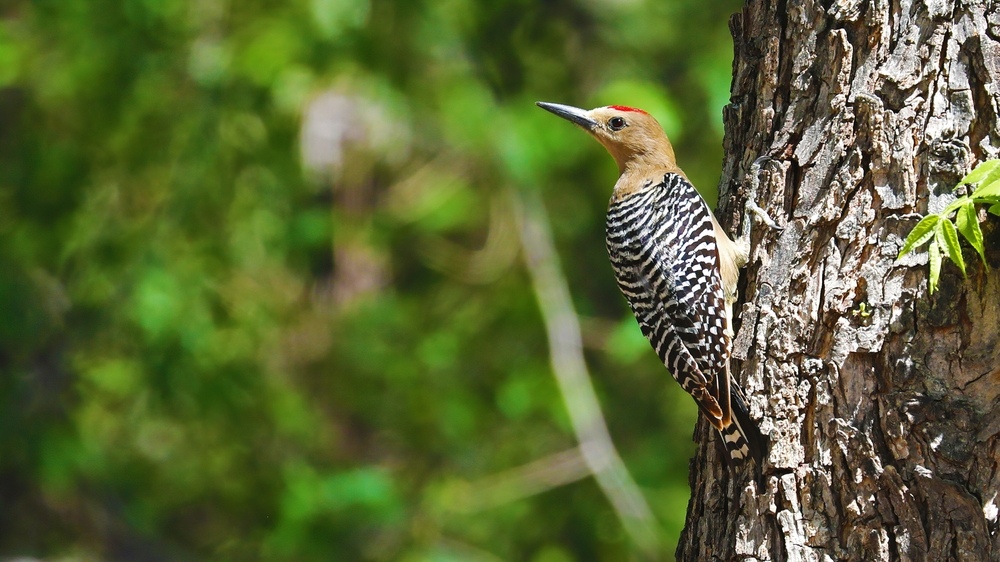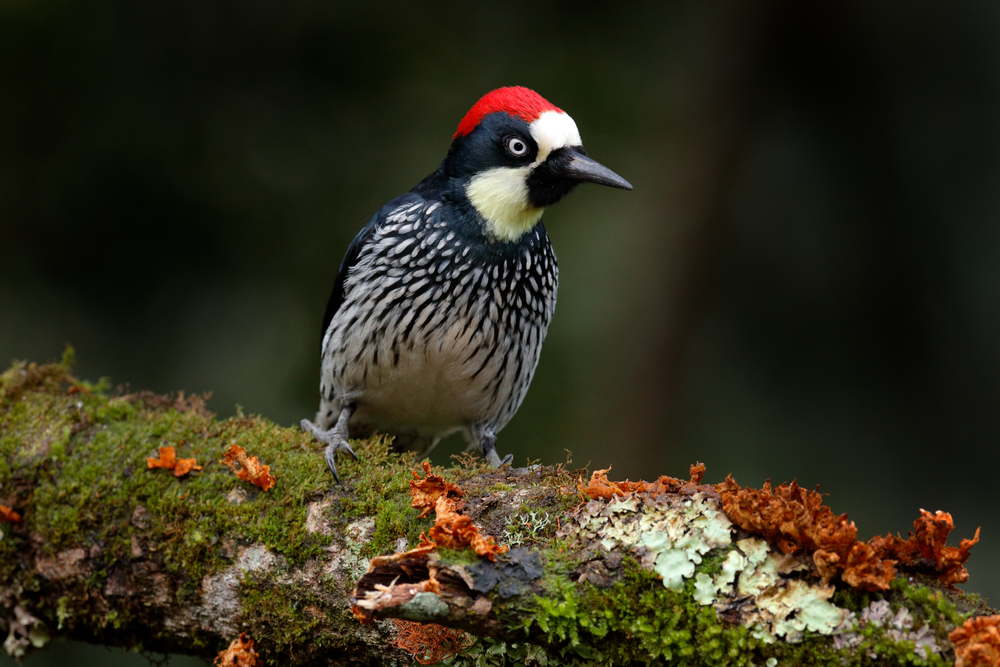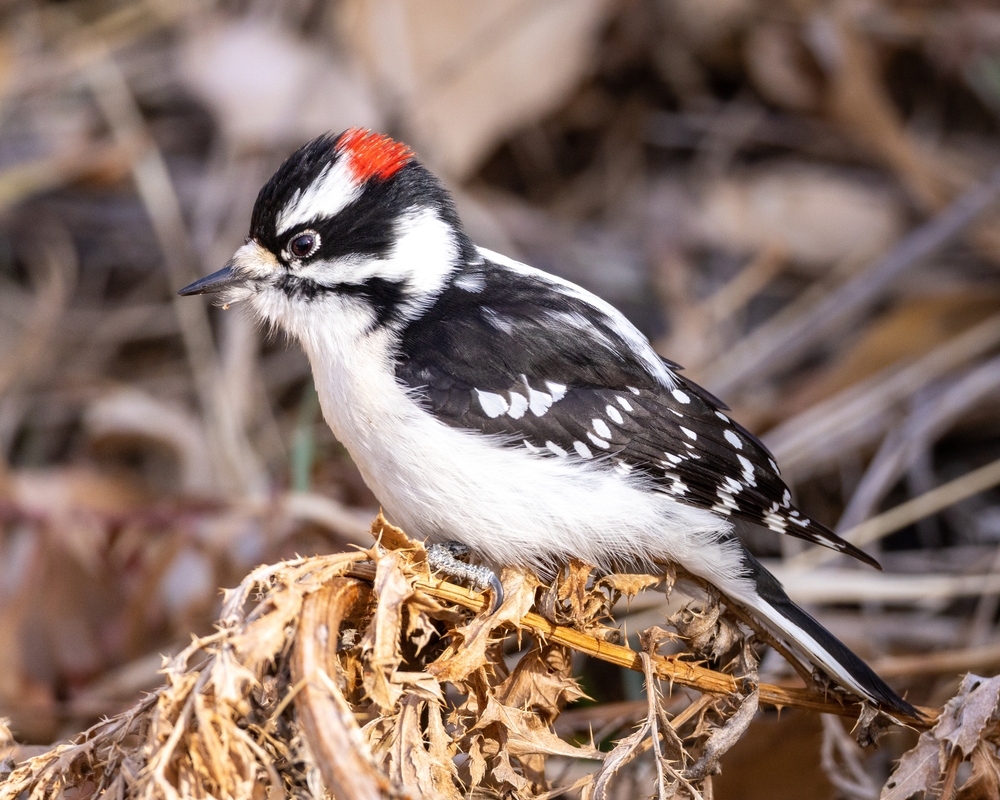The Gila Woodpecker (Melanerpes uropygialis) is closely related to other woodpeckers in the genus Melanerpes, especially the Golden-fronted Woodpecker (M. aurifrons) and the Red-bellied Woodpecker (M. carolinus), which share similar body structure and behaviors.
About
The Gila Woodpecker (Melanerpes uropygialis), a member of the Picidae family, is a striking bird native to the arid regions of the southwestern United States and northern Mexico. Well adapted to desert life, it is especially associated with the Sonoran Desert, where it often nests in saguaro cacti, making it one of the most iconic desert-dwelling woodpeckers.
Medium-sized at 22–26 cm (8.5–10 in) in length with a wingspan of about 40 cm (16 in), the Gila Woodpecker has a distinctive appearance. Its back and wings are barred black and white, while the underparts are light gray to tan. Males sport a small red cap on the crown, absent in females. Its strong bill and sharp claws are perfectly adapted for climbing cactus spines and drilling into wood or cactus flesh.
The Gila Woodpecker’s diet is highly varied, reflecting its adaptability. It consumes insects, spiders, fruits, berries, and seeds, and also feeds on nectar and sap. In urban areas, it readily visits bird feeders and is even known to sip from hummingbird feeders. Its desert diet makes it an important pollinator and seed disperser.
Breeding is closely tied to saguaro cacti, where pairs excavate nesting cavities. These cavities not only provide safe nesting sites for the woodpeckers but are later reused by many desert species, such as owls, kestrels, and other small birds, making the Gila Woodpecker a keystone species in desert ecology. Clutches typically contain 3–5 eggs, with both parents sharing incubation and chick-rearing duties.
Although common in its range, the Gila Woodpecker faces threats from habitat loss due to urbanization and decline of mature saguaros. Nevertheless, it remains a thriving species and an unmistakable part of the desert soundscape, with its loud calls and drumming echoing through cactus forests.
Physical Characteristics
The Gila Woodpecker is a medium-sized woodpecker of the American Southwest and Mexico, easily recognized by its sandy coloration and bold markings:
Head and Face:
They have a tan to grayish head and underparts. Males display a small red patch on the crown, while females lack this marking. Their face is plain, with a pale bill and dark eyes.
Beak:
The beak is long, straight, and sturdy, dark gray to black in color, designed for chiseling into wood, cacti, and foraging for insects.
Plumage:
The back, wings, and tail are barred with bold black-and-white patterns, while the underparts are light brown to buff. In flight, large white wing patches are clearly visible.
Body and Build:
They have a slender, medium build with stiff tail feathers for support while climbing. Their feet are zygodactyl (two toes forward, two backward), providing a strong grip on bark and cactus surfaces.
Size:
-
Length: 8 to 10 in (20 to 25 cm)
-
Wingspan: 15 to 17 in (38 to 43 cm)
-
Weight: 1.8 to 2.8 oz (51 to 79 g)
The Gila Woodpecker’s combination of sandy underparts, bold black-and-white barring, and desert habitat make it a distinctive and easily identified species of the arid Southwest.
Reproduction
The reproductive cycle of the Gila Woodpecker is closely tied to its desert habitat and reliance on cacti for nesting:
1. Courtship and Pair Formation:
Courtship occurs in early spring, with males drumming, calling, and displaying around potential nesting cavities. Once paired, they are generally monogamous for the season.
2. Breeding Season:
Breeding typically occurs from April to July, timed with warmer weather and greater insect availability in the Sonoran Desert.
3. Nesting:
Gila Woodpeckers excavate cavities in living saguaro cacti or mesquite trees. In saguaros, the cactus tissue creates a hardened “boot” around the cavity, which provides insulation and protection for the nest.
4. Egg Laying:
The female lays 3 to 5 white eggs per clutch. In favorable conditions, they may raise two broods in a season.
5. Incubation:
Incubation lasts about 14 days, with both parents sharing duties.
6. Chick Development:
Chicks hatch blind and helpless, covered in sparse down. Both parents feed them a diet of insects and fruit, regurgitated into their beaks.
7. Fledging and Independence:
The young fledge at about 21 to 25 days of age. After fledging, they remain with their parents for several weeks while learning to forage.
By nesting in cacti and sharing parental responsibilities, Gila Woodpeckers have adapted their reproduction to thrive in harsh desert environments.
Lifespan
The Gila Woodpecker is a hardy desert bird, with survival closely tied to cactus-rich habitats and seasonal food availability.
Lifespan in the Wild:
In their natural desert environment, Gila Woodpeckers typically live 6 to 10 years, though many face high mortality in their first year. Some individuals may survive longer in stable territories with good food supplies.
Lifespan in Captivity:
With steady food and veterinary care, they can live significantly longer, sometimes reaching 12 to 15 years in managed care.
Threats to the Gila Woodpecker:
-
Predation: Eggs and chicks are taken by snakes, other birds, and small mammals. Adults may fall prey to hawks and owls.
-
Habitat Loss: Removal of saguaros and mesquite trees reduces nesting and feeding opportunities.
-
Competition: Other cavity-nesting birds, such as European Starlings and Gilded Flickers, compete aggressively for nest sites.
-
Climate Stress: Prolonged droughts reduce insect and fruit availability, limiting survival and reproduction.
Despite these threats, the Gila Woodpecker’s adaptability and use of diverse nesting sites allow it to remain a successful resident of the Sonoran Desert and surrounding regions.
Eating Habits
The Gila Woodpecker has a diverse and adaptable diet that allows it to thrive in arid desert habitats:
Diet:
Their diet consists of insects, fruits, seeds, and nectar. They eat ants, beetles, caterpillars, and spiders, along with cactus fruits, berries, and occasionally cultivated crops. They also visit hummingbird feeders for sugar water.
Feeding Strategy:
They forage actively on trees, cacti, and the ground, probing bark and vegetation for insects. They are also opportunistic, taking advantage of human-provided foods in urban and suburban areas.
Role in Ecosystem:
By feeding on cactus fruits and berries, Gila Woodpeckers play a role in seed dispersal. Their excavation of cavities in saguaros also provides nesting sites for other desert animals once abandoned.
Social Feeding Behavior:
They are often seen in pairs or family groups, foraging together. During the breeding season, parents work cooperatively to gather food for chicks.
Feeding Technique:
They use their strong, straight beak to chisel into wood or cactus tissue. With their long, barbed tongue, they extract insects from crevices or sip nectar from flowers.
The Gila Woodpecker’s flexible feeding habits and ability to exploit both natural and human-influenced resources make it one of the most successful bird species of the Sonoran Desert.
Uniqueness
The Gila Woodpecker (Melanerpes uropygialis) is a desert specialist with several traits that set it apart from other woodpeckers:
Cactus Nesting:
They are best known for excavating nest cavities in living saguaro cacti. The cactus forms a hardened, waterproof “boot” around the cavity, providing insulation and protection for the nest.
Desert Adaptation:
Unlike most woodpeckers that inhabit forests, the Gila Woodpecker thrives in the arid Sonoran Desert, relying on saguaros, mesquite, and palo verde trees for food and shelter.
Dietary Flexibility:
They feed on insects, fruits, seeds, and nectar, and are frequent visitors to hummingbird feeders. Their ability to exploit diverse food sources gives them a survival advantage in harsh environments.
Ecosystem Engineers:
By creating cavities in cacti and trees, they provide essential nesting sites for other desert species, including Elf Owls, screech-owls, kestrels, and small mammals.
Distinctive Call:
Their rolling, chattering call and harsh “churr” sounds are unmistakable, often heard echoing across desert washes and cactus groves.
Cultural Icon:
The Gila Woodpecker is a defining bird of the American Southwest and is frequently associated with the unique landscapes of the Sonoran Desert.
The Gila Woodpecker’s cactus-nesting behavior, desert adaptations, and role as an ecosystem engineer make it one of the most remarkable and iconic birds of the desert.
Be the First to Share Photos of This Species.
FAQ’s
1. What species is closest to the Gila Woodpecker?
2. How does the Gila Woodpecker compare to other woodpeckers?
Unlike most woodpeckers that inhabit forests, the Gila Woodpecker is a desert specialist. It is unique for nesting in living saguaro cacti and for its flexible diet, which includes insects, fruit, seeds, and nectar. Compared to the Acorn or Downy Woodpeckers, it is more adapted to hot, arid climates and plays a key role as an “ecosystem engineer” in the desert.
3. What national parks provide the best opportunity to see a Gila Woodpecker?
The Gila Woodpecker is found in the Sonoran Desert of the southwestern United States and northwestern Mexico. Excellent parks to see them include:
-
Saguaro National Park, USA
-
Organ Pipe Cactus National Monument, USA
-
Joshua Tree National Park, USA
-
Anza-Borrego Desert State Park, USA
-
El Pinacate y Gran Desierto de Altar Biosphere Reserve, Mexico
These desert parks, rich in saguaros and other cactus species, provide the best opportunities to observe their nesting and feeding behaviors.





































































